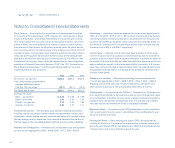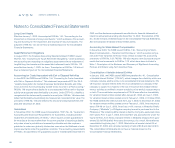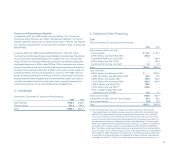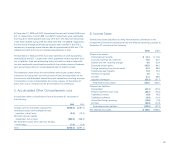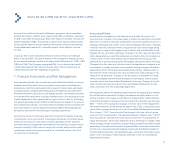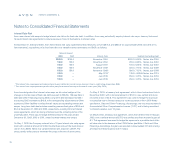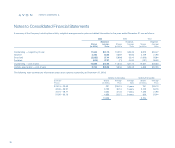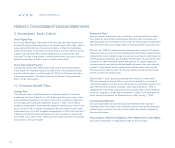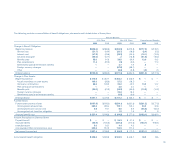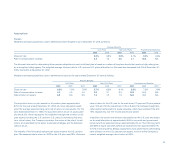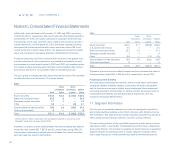Avon 2003 Annual Report Download - page 55
Download and view the complete annual report
Please find page 55 of the 2003 Avon annual report below. You can navigate through the pages in the report by either clicking on the pages listed below, or by using the keyword search tool below to find specific information within the annual report.
During 2003 and 2002, Avon held foreign currency forward contracts and
options to protect against the adverse effects that exchange rate fluctuations
may have on the earnings of its foreign subsidiaries. These derivatives do not
qualify for hedge accounting and, therefore, the gains and losses on these
derivatives have been recognized in earnings each reporting period and are
not material to the Consolidated Financial Statements.
Certain Avon subsidiaries hold U.S. dollar denominated assets, primarily to
minimize foreign-currency risk and provide liquidity. At December 31, 2003,
Avon’s subsidiary in Argentina held U.S. dollar denominated assets totaling
$6.0. At December 31, 2002, Avon subsidiaries that held U.S. dollar denomi-
nated assets included Mexico ($23.5), Argentina ($12.4), Venezuela ($6.8) and
Brazil ($7.6). For the years ended December 31, 2003 and 2002, Other expense
(income), net included net transaction losses of $2.8 and net transaction gains
of $27.8, respectively, related to these U.S. dollar denominated assets.
Hedges of Net Investments in Foreign Operations
Avon uses foreign currency forward contracts and foreign currency denomi-
nated debt to hedge the foreign currency exposure related to the net assets
of certain of its foreign subsidiaries.
During 2001, Avon entered into loan agreements and notes payable to borrow
Japanese yen to hedge Avon’s net investment in its Japanese subsidiary (see
Note 4, Debt and Other Financing). During 2001, Avon also entered into foreign
currency forward contracts to hedge its net investment in its Mexican subsidiary.
The Mexican peso forward contracts were settled in 2002. For the years ended
December 31, 2003 and 2002, net losses of $9.2 and $.8, respectively, and in
2001 net gains of $5.1, related to the effective portion of these hedges were
included in foreign currency translation adjustments within Accumulated other
comprehensive loss on the Consolidated Balance Sheets.
Credit and Market Risk
Avon attempts to minimize its credit exposure to counterparties by entering
into interest rate swap, forward rate, interest rate cap contracts and treasury
lock agreements only with major international financial institutions with “A”
or higher credit ratings as issued by Standard & Poor’s Corporation. Avon’s
foreign currency and interest rate derivatives are comprised of over-the-counter
forward contracts, swaps or options with major international financial institu-
tions. Although the Company’s theoretical credit risk is the replacement cost at
the then estimated fair value of these instruments, management believes that
the risk of incurring credit risk losses is remote and that such losses, if any,
would not be material.
Non-performance of the counterparties on the balance of all the foreign
exchange and interest rate swap and forward rate agreements would not
result in a material write-off at December 31, 2003. In addition, in the event of
non-performance by such counterparties, Avon would be exposed to market
risk on the underlying items being hedged as a result of changes in foreign
exchange and interest rates.
Fair Value of Financial Instruments
The fair value of a financial instrument is the amount at which the instrument
could be exchanged in a current transaction between willing parties, other
than in a forced sale or liquidation.
The methods and assumptions used to estimate fair value are as follows:
Grantor trust — The fair values of these investments, principally fixed income
funds and equity securities, were based on the quoted market prices for
issues listed on securities exchanges.
Notes to Consolidated Financial Statements
notes to statements
74


